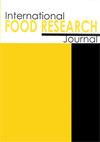Determination of bioactive components in different tomato lines: Physicochemical properties and antioxidant activity
IF 0.7
4区 农林科学
Q4 FOOD SCIENCE & TECHNOLOGY
引用次数: 0
Abstract
Tomato, one of the most produced vegetables in the world, is experiencing continuous global increase in both production and consumption. Fruit quality traits are important for fresh market tomatoes as well as for the processing industry. Despite the growing demand for both fresh and processed tomatoes, consumers are not satisfied with the quality of available fruits. The main objectives of the present work were to determine the physicochemical characteristics [pH, total soluble solids (TSS), total titratable acids (TTA), TSS/TTA ratio, DMC, lycopene, β-carotene, vitamin C, and total phenolic content], as well as the antioxidant activity of 13 different tomato lines, and to identify the most promising ones in terms of fruit taste and quality. Antioxidant activity was determined using the ABTS and DPPH methods with Trolox used as the standard compound. PCA analysis was conducted to identify group patterns. The results of PCA analysis indicated a specific genotypic response in all investigated physicochemical traits. Genotypes 2, 10, and 13 were identified as the best for fresh consumption, as they exhibited the highest levels of compounds crucial for good taste, nutrition, and human health benefits. The most promising genotype related to fruit quality attributes was genotype 10 with the best TSS and TAA content and TSS/TAA ratio, which is important for overall taste perception. On the other hand, genotype 9 showed promise for industrial purposes due to its ideal pH value in the juice and good soluble solid content. High antioxidant activity was characteristic of genotypes 1 and 2, and their consumption as fresh tomatoes can be beneficial to human health. They also should be considered for further evaluation as potentially interesting genotypes for abiotic stress research and selection programs which can lead to the development of both superior fruit quality and stress tolerant genotypes.测定不同番茄品系中的生物活性成分:理化特性和抗氧化活性
番茄是世界上产量最高的蔬菜之一,全球产量和消费量都在持续增长。番茄果实的品质特征对于新鲜上市的番茄和加工业都非常重要。尽管对新鲜番茄和加工番茄的需求不断增长,但消费者对现有水果的质量并不满意。本研究的主要目的是测定 13 个不同番茄品系的理化特性[pH 值、总可溶性固形物(TSS)、总可滴定酸(TTA)、TSS/TTA 比值、DMC、番茄红素、β-胡萝卜素、维生素 C 和总酚含量]以及抗氧化活性,并找出在水果口感和质量方面最有潜力的品系。抗氧化活性的测定采用 ABTS 和 DPPH 法,以 Trolox 为标准化合物。进行了 PCA 分析,以确定组别模式。PCA 分析结果表明,在所有调查的理化性状中都存在特定的基因型反应。基因型 2、10 和 13 被确定为最适合新鲜食用的品种,因为它们表现出最高水平的化合物,这些化合物对口感、营养和人体健康至关重要。与果实品质属性相关的最有前途的基因型是基因型 10,其 TSS 和 TAA 含量以及 TSS/TAA 比值均为最佳,而 TSS/TAA 比值对整体口味感知非常重要。另一方面,基因型 9 具有理想的果汁 pH 值和良好的可溶性固形物含量,因此有望用于工业用途。基因型 1 和 2 的特点是抗氧化活性高,作为新鲜番茄食用对人体健康有益。此外,还应该考虑对这两个基因型进行进一步评估,将其作为非生物胁迫研究和选育计划的潜在有趣基因型,从而开发出果实质量上乘且耐受胁迫的基因型。
本文章由计算机程序翻译,如有差异,请以英文原文为准。
求助全文
约1分钟内获得全文
求助全文
来源期刊

international food research journal
Agricultural and Biological Sciences-Food Science
CiteScore
1.40
自引率
0.00%
发文量
75
期刊介绍:
The International Food Research Journal (IFRJ) publishes papers in English, six (6) issues a year with the coverage of:
Food Science and Technology
Nutrition and Dietetics
Agriculture, multidisciplinary
Chemistry, multidisciplinary
The scope of the Journal includes:
Food Science, Food Technology and Food Biotechnology
Product Development and Sensory Evaluation
Food Habits, Nutrition, and Health
Food Safety and Quality
Food Chemistry, Food Microbiology, Food Analysis and Testing
Food Engineering
Food Packaging
Food Waste Management
Food Entrepreneur
Food Regulatory
Post-Harvest Food Management
Food Supply Chain Management
Halal Food and Management
 求助内容:
求助内容: 应助结果提醒方式:
应助结果提醒方式:


